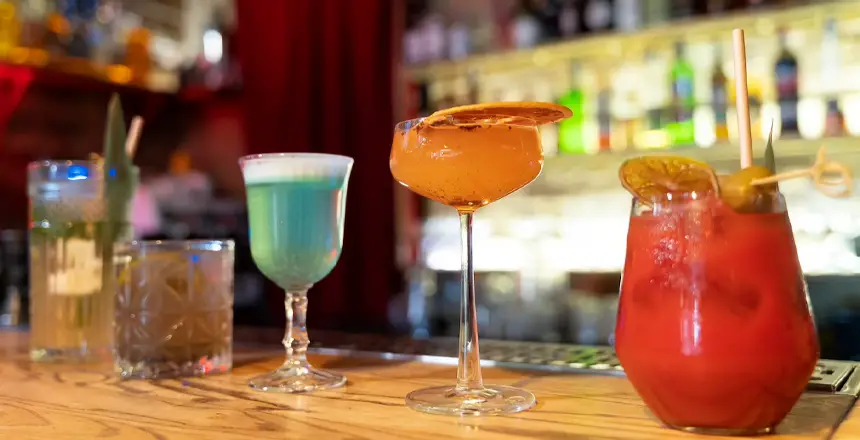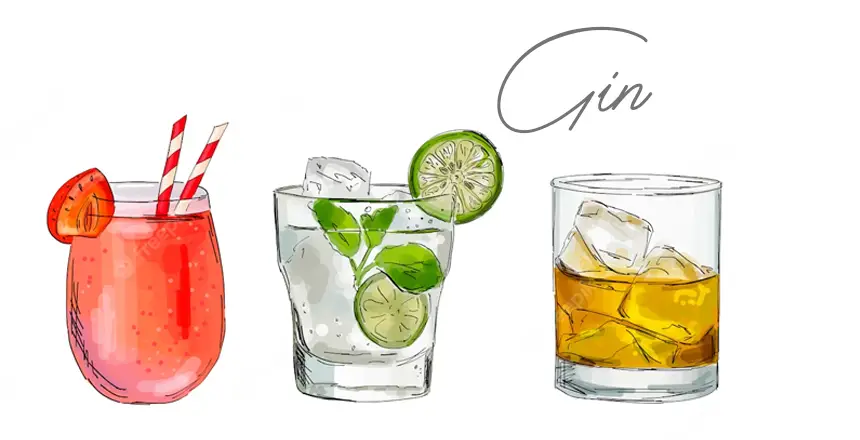Gin has become one of the world’s favorite spirits in recent years, with a variety of different styles available. But what does gin taste like? It’s certainly complex, varied and even confusing to some.
In this post we will explore why that is, by looking at its unique history, production process and most importantly — the flavors it holds within its bottle!
From classic juniper-led London Dry Gin to more contemporary botanical-packed Craft Gin expressions – let’s take a deep dive into the spirit and discover what makes gin so wonderfully intriguing – because there really is something for everyone!
Related:
What is Gin?

Gin is a distilled spirit that is primarily flavored with juniper berries. It is typically made from grains such as barley, corn, or wheat and is flavored with a combination of botanicals such as coriander, angelica root, citrus peel, and other herbs and spices.
There are several different types of gin, each with its own unique flavor profile:
- London Dry Gin – This is the most common type of gin, known for its dry and aromatic flavor. It must be made with all-natural botanicals and cannot have any added sweeteners or colorings.
- Plymouth Gin – This type of gin is made exclusively in Plymouth, England and has a slightly sweeter and more earthy flavor than London Dry Gin.
- Old Tom Gin – This type of gin is slightly sweeter than London Dry Gin and is often used in classic cocktails like the Tom Collins and the Martinez.
- Genever – This is a Dutch style of gin that has a maltier flavor and is often compared to whiskey. It can be aged in barrels, similar to whiskey, which gives it a unique flavor profile.
For a better understanding of gin’s origin, click here.
The Flavor Profile of Gin

The primary flavor notes of gin
Gin is a type of alcoholic beverage that is predominantly infused with juniper berries, resulting in a unique taste that is characterized by a blend of piney and herbaceous flavors. This strong juniper flavor is what sets gin apart from other spirits like vodka or rum.
Some other primary flavor notes in gin include citrus, spice, and floral undertones. These notes can come from a variety of botanicals used in the distillation process, such as coriander, cardamom, angelica root, orris root, and others.
Secondary flavors and aromas commonly found in gin
Secondary flavors and aromas commonly found in gin can vary depending on the specific type and brand of gin. For example, some gins may have a more pronounced citrus flavor, with notes of grapefruit, lemon, or lime.
Others may have a spicier profile, with hints of black pepper, cinnamon, or ginger. Some gins may also have a more floral aroma, with notes of lavender, rose, or chamomile.
These secondary flavors and aromas can come from additional botanicals added during the distillation process, or from the way the gin is aged or blended.
Overall, the flavor profile of gin can be quite complex and nuanced, with many different botanicals contributing to the overall taste and aroma.
Developing your palate for gin can take time and practice, but paying attention to the different flavors and aromas present in the gin can help you better appreciate and enjoy this unique spirit.
What Affects the Taste of Gin?
The taste of gin is truly affected by a number of different factors, including the types of botanicals utilized during the production process. Each botanical can lend its own unique flavor to the gin, and the combination of botanicals can make for a wholly different taste experience.
Distillation methods also play a role, as the heat and pressure can impact the overall flavor profile of the gin.
Additionally, how the gin is aged and blended can also have an impact on its taste. From start to finish, it takes a careful, specialized approach to create the perfect bottle of gin.
Techniques for Developing Your Palate and Identifying Different Flavors and Aromas in Gin
Developing your palate and identifying different flavors and aromas in gin is a precise art form that requires patience and dedication
- Taste different types of gin: Sampling a range of gins can help you identify the differences in flavor profiles between various brands and styles.
- Experiment with mixers and garnishes: Try adding different mixers or garnishes to your gin to enhance or complement its flavors and aromas.
- Take note of the botanicals: Juniper berries are the most common botanical used in gin, but other botanicals like coriander, citrus peel, and cardamom can also contribute to its flavor.
- Pay attention to the aroma: The aroma of gin can be just as important as its taste, so try to identify the different scents present in the gin you are tasting.
- Use a tasting chart: Some people find it helpful to use a tasting chart or flavor wheel to guide their analysis of the gin’s flavor and aroma.
Tips for Serving and Storing Gin
Gin is a timeless classic that has been a favorite among spirits for centuries. It’s versatile, refreshing, and can be enjoyed in a variety of cocktails.
To serve gin like a pro, start by choosing the right glass. A highball or a Collins glass is perfect for serving gin and tonics, while a martini glass is ideal for classic gin cocktails like the gin martini.
When it comes to storing gin, keep it in a cool, dry place away from direct sunlight. Exposure to heat and light can change the flavor of the gin, so it’s best to store it in a dark cabinet. Also, make sure to keep the bottle upright to prevent the cork from drying out.
FAQs
What are the differences between gin and whiskey in terms of flavor and production?
The main difference between gin and whiskey is the base ingredient used to produce the spirit. Gin is usually made from a grain neutral spirit and flavored with juniper berries and other botanicals, while whiskey is made from fermented grains such as barley, corn or wheat.
Read more about whiskey taste here.
Is gin a sweet or bitter drink?
Gin can be both sweet and bitter, depending on the style of gin. London Dry gins are usually dry and aromatic, while Old Tom Gins have a more pronounced sweetness.
Plymouth Gins have an earthy sweetness to them as well. The botanicals used in the production process also play a large role in determining the flavor profile of the gin.
What is the main flavor in gin?
The main flavor in gin is juniper. Juniper berries are what give gin its signature dry, pine-like flavor. Other botanicals such as citrus peel and herbs can also be used in the production of gin, resulting in a variety of different flavor profiles.
What are some common botanicals used in gin production?
Common botanicals used in gin production include juniper, coriander seeds, angelica root, citrus peel, and other herbs and spices. Each of these botanicals contributes to the flavor profile of gin in its own unique way.
Can the taste of gin vary between brands?
Yes, the taste of gin can vary greatly between brands. Different distillers use different techniques and botanicals in their production process, which results in a range of different flavor profiles.
It is important to try several brands of gin before deciding on one that best suits your individual tastes.
What kind of cocktails can I make with gin?
Gin is a versatile spirit that can be used to make a variety of classic cocktails. Some popular gin-based cocktails include the Martini, Negroni, Gin and Tonic, Tom Collins, and many more. Experiment with different ingredients and proportions to find your own unique cocktail recipes!
Take Home Message
Gin is a complex spirit with a wide range of flavour profiles. Some consider it a gateway to the world of mixology, while others find its natural flavours pleasant and refreshing on their own.
Whether you enjoy sipping gin neat and without any frills, or as part of an expertly crafted cocktail, you can enjoy gins from all around the world. There are so many varieties available that there’s something for everyone.
Experimentation has never been more fun – make sure to let us know how it turns out! What Does Gin Taste Like? | An In-Depth Guide was a pleasure to write – we hope you had just as much fun reading it!


